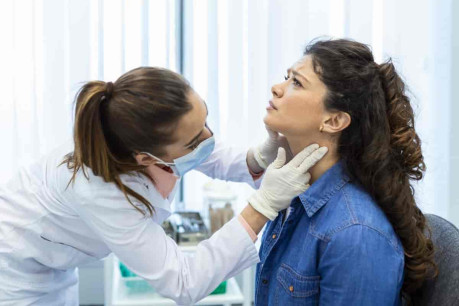Strep Throat: Symptoms, Treatment, and What to Expect
Learn what strep throat is, its symptoms, how long it lasts, and if it’s contagious. Discover effective strep throat treatment and how to recognize its warning signs.

Strep throat affects millions of people each year, particularly children and teens during school season. Understanding strep throat symptoms, knowing when it’s contagious, and recognizing proper treatment options can help you or your child recover quickly and prevent spreading this bacterial infection to others.
What is Strep Throat?
Strep throat is a bacterial infection caused by group A Streptococcus bacteria that affects the throat and tonsils. Unlike viral sore throats, strep throat requires antibiotic treatment and causes specific symptoms including fever, red swollen tonsils with white patches, and swollen lymph nodes.
About 15% of children with sore throat and fever actually have strep throat. The infection is most common among school-age children (5-15 years old) but can affect anyone at any age. Strep throat occurs more frequently during fall and winter months when people spend more time in close contact indoors.
Strep Throat Symptoms: What Does It Look Like?
Signs of strep throat typically develop suddenly, within 1-3 days after exposure. Symptoms include:
- Severe sore throat - Pain when swallowing, often described as feeling like “glass in the throat”
- High fever - Usually 101°F (38.3°C) or higher, may include chills
- Red, swollen tonsils - Often with white patches, streaks, or pus-filled spots
- Swollen lymph nodes - Tender, enlarged glands in the neck
- Headache and body aches - General feeling of illness and fatigue
- Difficulty swallowing - May extend to difficulty eating or drinking
- Loss of appetite - Often accompanied by nausea or stomach pain
- Small red spots - Tiny petechiae on the roof of the mouth
Strep Throat vs. Viral Sore Throat
| Characteristic | Strep Throat (Bacterial) | Viral Sore Throat |
|---|---|---|
| Onset | Sudden, severe | Gradual development |
| Fever | High (101°F+) | Low-grade or none |
| Other symptoms | No cough, congestion | Runny nose, cough, hoarseness |
| Treatment | Requires antibiotics | Rest and fluids |
Is Strep Throat Contagious?
Strep throat is highly contagious for 24-48 hours after antibiotic treatment begins. Without treatment, patients remain contagious for 2-3 weeks. The bacteria spreads through respiratory droplets when infected people cough, sneeze, or talk, and through contact with contaminated surfaces.
How Strep Throat Spreads
- Respiratory droplets - Released when coughing, sneezing, or talking
- Direct contact - Shaking hands with infected person
- Contaminated surfaces - Touching doorknobs, phones, or shared items
- Sharing items - Utensils, drinks, food, or personal items
Strep Throat Treatment Options
Antibiotic Treatment
Doctors typically prescribe antibiotics for 10 days to treat strep throat effectively. Common antibiotics include:
- Penicillin (first choice for most patients)
- Amoxicillin (often preferred for children)
- Erythromycin or azithromycin (for penicillin-allergic patients)
- Cephalexin (alternative option)
Home Care and Symptom Relief
- Stay hydrated - Drink plenty of warm liquids like tea with honey or broth
- Rest - Get adequate sleep to help your immune system fight the infection
- Pain relief - Use acetaminophen or ibuprofen for fever and pain
- Throat soothing - Try warm salt water gargles or throat lozenges
- Soft foods - Eat ice cream, smoothies, or soup to reduce throat irritation
How Long Does Strep Throat Last?
With antibiotic treatment, strep throat symptoms improve within 24-48 hours, and most people feel better in 3-5 days. Without treatment, symptoms can last 7-10 days, but complications may develop, extending recovery time significantly.
Recovery Timeline With Treatment
- Within 24 hours: Fever begins to decrease, no longer contagious
- 24-48 hours: Throat pain starts improving
- 3-5 days: Most symptoms resolve
- Complete course: Must finish all antibiotics (usually 10 days)
Recovery Without Treatment
Without treatment, strep throat symptoms may resolve in 7-10 days, but patients remain contagious for 2-3 weeks and risk serious complications including:
- Rheumatic fever (can damage heart valves)
- Kidney inflammation (post-streptococcal glomerulonephritis)
- Scarlet fever
- Blood infections (sepsis)
- Abscess formation around tonsils
When to See a Doctor: Warning Signs
Contact your healthcare provider if you or your child experiences:
- Severe sore throat lasting more than 48 hours
- Fever of 101°F (38.3°C) or higher
- Difficulty swallowing or breathing
- White patches or pus on tonsils
- Swollen, tender lymph nodes in neck
- Rash accompanying sore throat symptoms
- Symptoms worsen after starting antibiotic treatment
Emergency Warning Signs
Seek immediate medical attention for:
- Severe difficulty swallowing or breathing
- Drooling due to inability to swallow
- Signs of dehydration
- High fever not responding to medication
- Severe neck stiffness
Preventing Strep Throat Spread
Reduce transmission risk with these prevention strategies:
- Practice good hygiene - Wash hands frequently with soap for 20 seconds
- Avoid sharing personal items - Don’t share utensils, cups, or toothbrushes
- Cover coughs and sneezes - Use elbow or tissue, not hands
- Stay home when sick - Remain home until 24 hours after starting antibiotics
- Clean surfaces regularly - Disinfect frequently-touched objects and surfaces
- Replace personal items - Change toothbrush after starting treatment
FAQs
Can strep throat go away without antibiotics?
How do you test for strep throat?
Can adults get strep throat?
Is strep throat seasonal?
Cite this page:
- Posted by Tamseel Ch